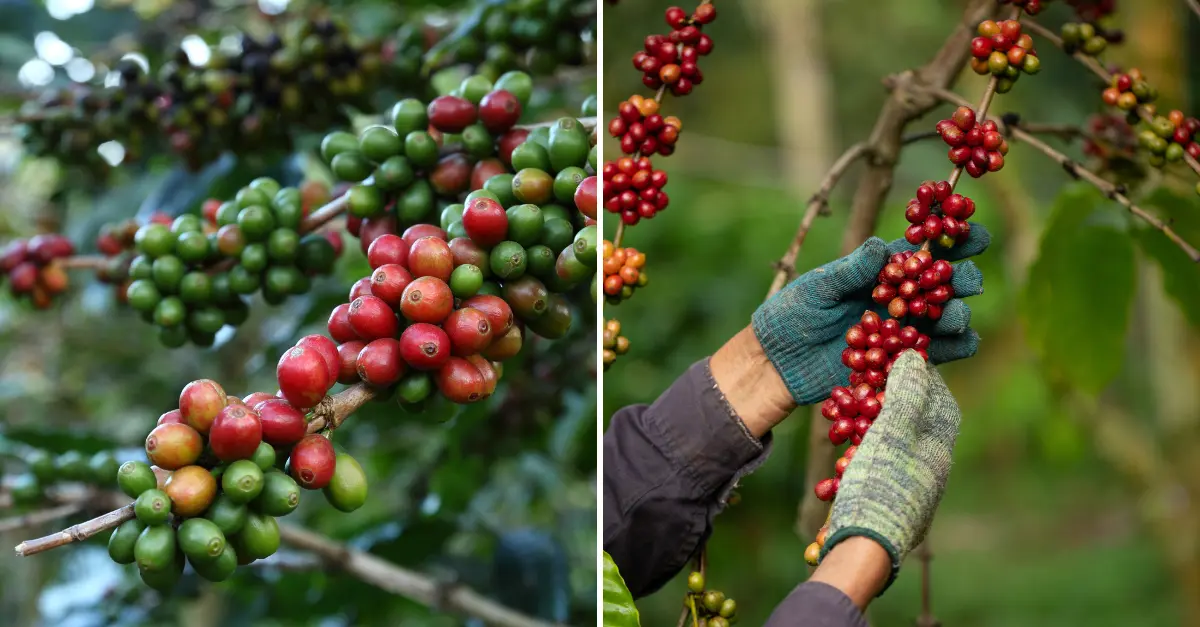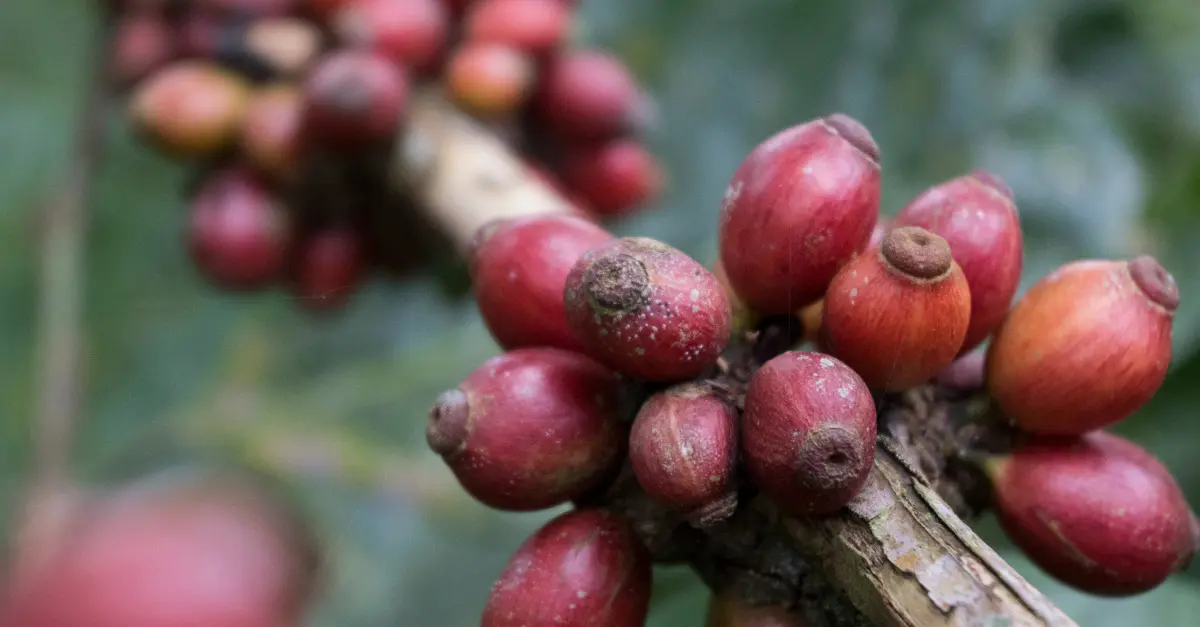Over a dozen different coffee species exist today. However, Arabica and robusta coffee varieties enjoy the majority of the global market’s pie. To understand why these two varieties stand out the most and thrive on the market, a detailed Arabica vs robusta coffee beans comparison is essential. This is exactly what you will find in this guide.
Arabica and Robusta Coffee Bean: Overview
Arabica and robusta coffee varieties both belong to the flowering plant family of Rubiaceae or coffee seed-bearing plants. However, this is as far as their similarities go. Arabica and robusta coffee trees are different species, commonly known as Coffea Arabica and Coffea Canephora.
What is the Main Difference between Arabica and Robusta Coffee Beans?
The main difference between Arabica and robusta beans is their species. While they are both coffee plants, each is a unique species. Arabica coffee belongs to the Coffea arabica species while robusta coffee belongs to the Coffea canephora species.
This, in turn, gives them unique properties and characteristics. For instance, Arabica coffee beans develop a smoother and sweeter taste with fruity, berry, chocolate, or sugar notes. On the other hand, robusta coffee beans develop a stronger and bitter taste with earthier notes and grainy overtones. Robusta coffee also contains nearly twice the caffeine content as Arabica coffee.
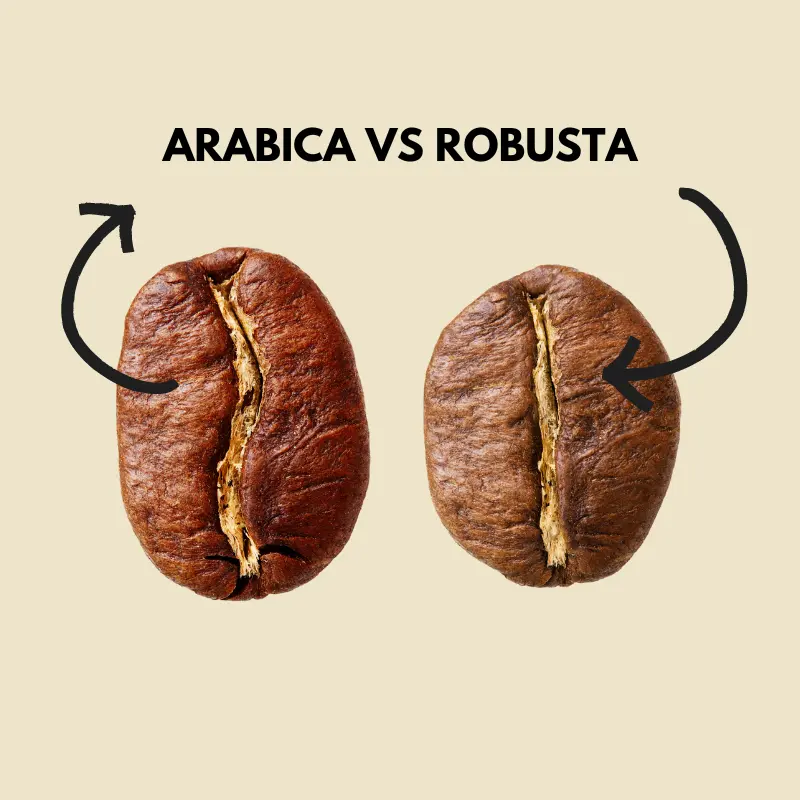
Arabica Coffee Beans
Arabica Physical Properties
Coffea Arabica is a dwarf-like coffee plant that grows to a height of between 6.5 and 39 feet tall, depending on the variety. This plant typically grows as a shrub in an open branching system with opposing leaves in an elliptic ovate to oblong shape. The leaves are about 2.5 to 4.5 inches long and 1.5 to 3 inches wide and develop a dark glossy green hue.
The shrub tree also produces white and sweet-smelling flowers that bloom annually. During their blooming period, the sweet fragrance of the arabica flowers is reminiscent of Jasmine flowers. On the other hand, the arabica coffee cherry starts with a green color and transitions into a red to purple hue upon maturity. While arabica beans contain two seeds per bean, a special peaberry variety contains a single seed in every bean.
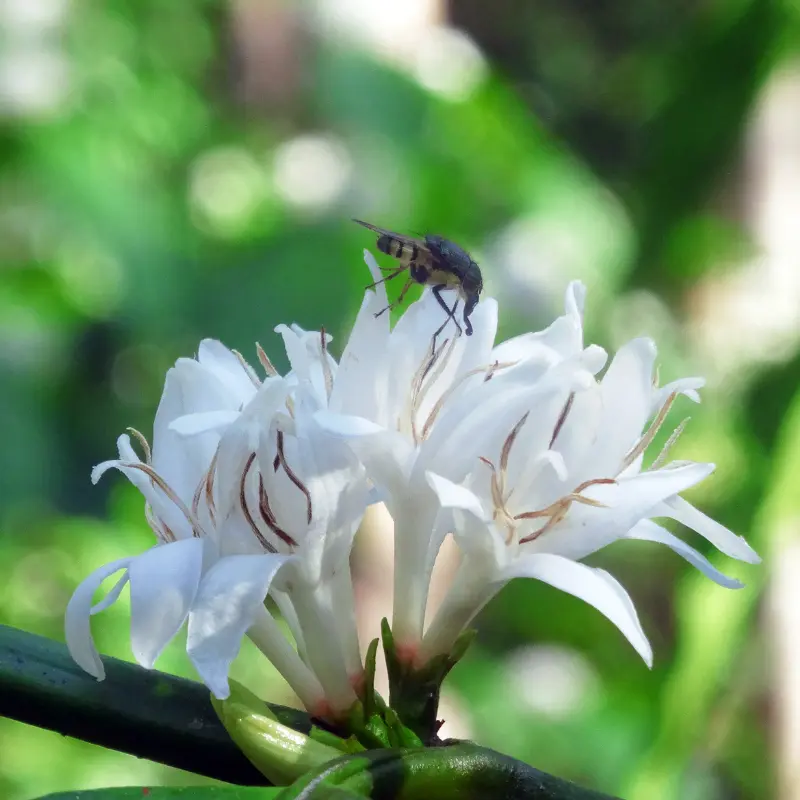
Arabica Origin
Also known as Arabic coffee, arabica coffee is believed to be the first coffee species to be cultivated and it remains to be the most consumed species today. The species naturally occurs in southern Ethiopia and Yemen, where it is believed to originate from.
However, while Ethiopia is believed to be the origin of coffee plants, particularly arabica, the origins are sometimes disputed – at least the -origins of the overall coffee plants, and the first coffee plants to exist - not arabica.
Coffea arabica is believed to be a hybridization of the Coffea canephora (particularly Robusta) and Coffea Eugenioides between 1 million and 543,000 years ago due to the environmental changes experienced in East Africa during this time.
Canephora traces its origins in central and western sub-Saharan Africa while Eugenioides traces its origins from East Africa (particularly DRC, Rwanda, Uganda, Kenya, and western Tanzania). Today, arabica coffee is grown across most countries in the coffee belt (or coffee growing regions). This species dominates the global market share, accounting for about 70% of the total coffee production and sales.
Arabica Growing Conditions
Arabica coffee thrives in high altitudes, growing between 2,000 and 6,500 feet, depending on the region. Nonetheless, while arabica coffee loves low temperatures, it doesn’t tolerate frost, preferring temperatures of between 59 and 75 degrees Fahrenheit.
The higher the altitude, the more flavors you will enjoy. At these altitudes, the land is rich in minerals which works in favor of the heavy-feeding plants and contributes to its flavors. This explains why coffee growing on the foothills of volcanic mountainous areas tends to be delicious!
Surviving in high altitudes, arabica coffee prefers less rainfall annually and less sunlight. This, in turn, prolongs its growth period, giving the plant enough time for its cherries to develop its sugars and ultimately, its deeper and more complex flavors. This explains why arabica coffee beans are sweeter and more aromatic than robusta beans. The altitude range sets the flavor criteria of arabica coffee.
Arabica Characteristics
Here’s an overview of the standard arabica coffee flavor profiles based on the altitude;
| Altitude | Flavor profile | Examples of these regions |
|---|---|---|
| very high altitude (1500m/4921 ft) | Fruit, spice, floral, wine, and berry | Guatemala, Jamaica, Colombia, Ethiopia, Kenya Embu, Tanzania Mbeya & Kilimanjaro, Papua New Guinea |
| High altitude (1200m/3937 ft) | Citrus, vanilla, chocolate, and nut | Costa Rica, Mexico, Nicaragua, Tanzania Kilimanjaro ,Sumatra, and Java |
| Medium altitude(900m/2953ft) | Smooth and sweet | Brazil Bourbon Santos |
| Low altitude (760m/2493ft) & Very low altitude(600m/1969m) | Soft, mild, simple, almost bland | Hawaiian Kona |
Fun Fact: Brazil is the largest producer of arabica coffee in the world, accounting for 60% of the global arabica production.
Arabica coffee contains very little caffeine, about 1.16 grams for every 100 grams. However, it has more sugar content, about 6 to 9% of the total bean content. Arabica coffee is described as sweet with flavor notes varying from floral to fruity, spicy, and chocolatey. Arabica coffee also has a smooth feel with minimal to no bitterness and some acidity.
Compared to robusta coffee, arabica is more difficult to grow. This prized coffee plant is prone to pests and insects and requires more specialized growing conditions. While robusta can be grown in a wide variety of areas, arabica coffee plants require more unique growing conditions.
This explains why it was easy for hardier and more tolerant species like robusta and liberica to be adapted in newer and different environments, such as Asia, while it’s impossible to do so for arabica. With today’s climate change challenges, arabica coffee growers are more affected than robusta growers.
This is because the already limited Arabica growing areas are impacted due to the increase of average temperatures and warming of the earth. This leads the coffee growers to seek even higher elevations to accommodate their coffee plants.
Arabica Varieties
The most common types of arabica coffee beans include Typica and bourbon. Typica is the very first arabica species to be discovered. This is a low-yield variety with examples, such as Sumatra and Hawaiian Kona, Jamaica Blue Mountain.
Bourbon variety is a high quality variety with more complex and nuanced flavors, as its name suggests. This variety offers a distinctive sweetness. The bourbon variety, however, is a natural mutation of the typical variety. It first occurred on the island of Reunion. The typical variety was brought to the island by French colonizers and over time, it evolved into the bourbon variety.
Now, don’t confuse this name with the popular, delicious Kentucky whiskey variety. The name Bourbon refers to the island’s former colonial name, ile Bourbon or Bourbon Island. Today, the bourbon variety popularly grows in central and north-southern American regions, such as Guatemala, El Salvador, Honduras, and Peru.
Arabica coffee also comes in gourmet types, growing in specific parts of the world. These include Jamaican Blue Mountain, Hawaiian Kona, Antiguan Guatemala, Ethiopian Sidamo, Harrar, and Yirgacheffe, Costa Rican Tarrazu, and Colombian Supremo.
In this video, you will find out that coffee varieties vary worldwide due to diverse growing conditions, impacting yield and quality. Producers must choose the right variety to avoid costly mistakes. Traders benefit from knowing coffee varieties for predicting flavor profiles and prices accurately.
Robusta Coffee Beans
Robusta Physical Properties
Coffea Arabica is a small coffee plant that grows to a height of about 33 feet tall. It can grow as a tall standing or wide-spreading shrub with a shallow root system. This shallow root system makes robusta adaptable to many low-altitude conditions.
In general, robusta coffee plants easily grow in various areas than arabica, and are part of the reason why it was easily adapted in Asia from Africa. The plant grows glossy green mango-shaped leaves and white fragrant flowers. Their green cherries turn deep and darker red upon maturity. Like arabica coffee, their beans usually contain 2 seeds however; peaberry robusta contains a single seed.
Robusta Origin
Arabica coffee beans are native to a significant area of sub-Saharan Africa, stretching from Tanzania in the east to Liberia in the west. The coffee also natively grows in Central and Southern Africa, in countries, such as DRC and Angola. Today, robusta coffee grows well beyond Africa in the Americas and Asia.
Fun fact: Vietnam is the world’s largest producer of robusta coffee, accounting for over 40% of the total global production. While Brazil is the overall largest global producer of coffee and the arabica species, it ranks second to Vietnam when it comes to robusta beans- accounting for 25% of the total production.
Robusta Growing Conditions
Robusta coffee grows in much lower altitudes between 600 and 2400 feet. This coffee species prefers much warmer temperatures than arabica but not too warm. Moreover, robusta loves humidity and at lower altitudes, it enjoys this, due to the higher rainfall.
However, these conditions don’t produce coffee as sweet as arabica. Instead, robusta coffee develops an intense and strong coffee taste with woody and earthy tones. Robusta coffee also features a low acidity and high bitterness.
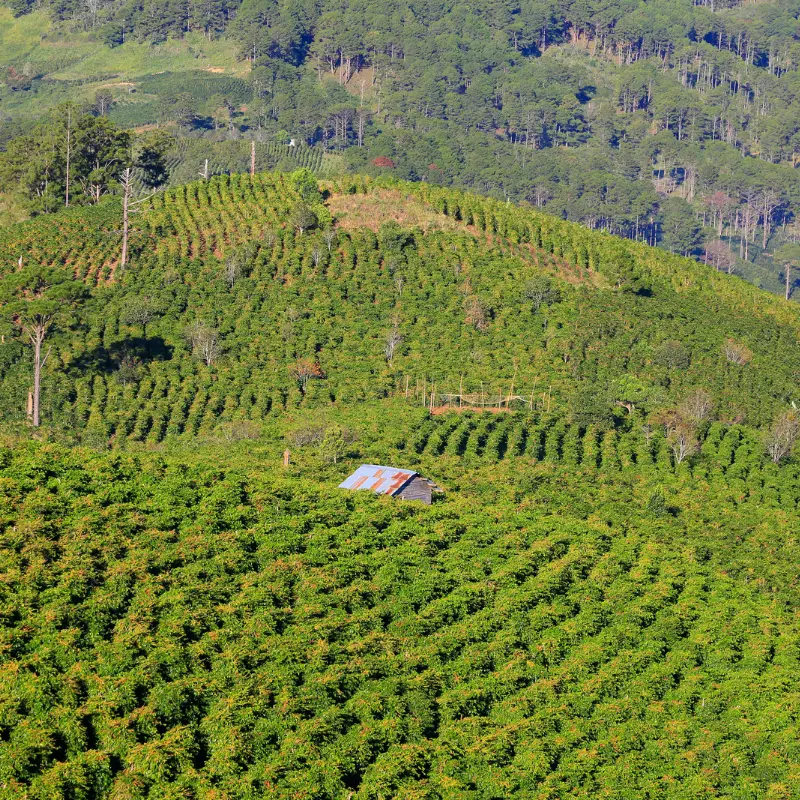
Robusta Characteristics
Compared to arabica coffee beans, robusta contains double the caffeine levels and more antioxidants. Robusta beans contain about 2.26 grams for every 100 grams. However, it contains half the sugar and lipid content as arabica, explaining why it has a less sweet taste. But, with the higher caffeine and antioxidant content, robusta coffee is believed to be a healthier coffee species than arabica.
Robusta coffee is easier to grow than arabica coffee as it is hardier, and thus, less susceptible to pests, insects, and diseases. The rich antioxidants AKA chlorogenic acid and high caffeine content of robusta beans are believed to give them their self-protective properties to repel pests and diseases. Unfortunately, these same high caffeine and chlorogenic acid levels affect the flavor and cup quality.
Since it grows at a lower altitude, there’s substantially more space to grow it than arabica. It is also easier to adopt in other regions, explaining its successful growth in Asia. Unlike arabica coffee plants, you don’t have to worry about consistent flower pruning to preserve the plant’s crop quality and yield. Therefore, because robusta is easier to grow, it is cheaper than arabica.
In the following video, you will learn that climate change threatens arabica coffee supply so Vietnamese farmers seek tastier robusta beans and resilient to warmer temperatures.
Robusta Varieties
Just because robusta has a less desired flavor, it doesn’t mean it is less consumed. Sure, arabica coffee is popularly enjoyed as a single origin, allowing drinkers to explore authentic flavors from different regions. But, robusta also boasts its own interesting use. This coffee variety is used primarily in instant coffee mixes and as a filler in ground coffee blends.
Robusta is also a popular coffee addition in espresso blends, allowing them to achieve their characteristics. Blenders and roasteries use the distinctive properties of robusta and arabica to create these impressive espresso blends. Robusta contains high pyrazine levels which give it its bitterness and strong and full-bodied earthy flavors.
But, robusta also produces a richer crema than arabica. On the other hand, arabica beans offer a more distinctive and signature flavor. Combined, these two species produce the perfect balance of strength and finish with an amazing crema – important qualities in an authentic Italian espresso! Up to 15% of the robusta beans are used in the espresso blends for their crema, intensity, full body, and extra caffeine kick as a bonus!
Arabica vs Robusta Coffee Beans: Summary Comparison
| Characteristics | Arabica Coffee | Robusta Coffee |
|---|---|---|
| Mature Bean Color, Shape, and Size | Bright red to purple, Elliptical or oval, 10-15mm in diameter | Rich and dark red, Circular and smaller, 8-9mm in diameter |
| Cherry | 2 seeds per bean 1 seed per bean (Peaberry) | 2 seeds per bean 1 seed per bean (Peaberry) |
| Caffeine Content | 1.16g/100g (1.5%) | 2.26g/100g (2.7%) |
| Sugar Content | 6-9% per bean | 3-7% per bean |
| Flavor Profile | Flavorful, sweeter, and aromatic | Woody and earthy with low acidity and high bitterness |
| Origin | Southern Ethiopia and Yemen, | Central, east, and western sub-Saharan Africa |
| Adopted Growing Region | Entire coffee belt | Sub-Saharan Africa, Asia, and the Americas |
| Plant Type and Height | Shrub, 6.5 – 39 feet | Shrub, 33 feet |
| Ideal temperature, rainfall, sunlight levels, etc. | 59 - 75 °F, Low annual rainfall Light shade | 71.6 – 78.8 °F, Heavy annual rainfall Shade to some sunlight |
| Growing Altitude | 2,000 to 6,500 feet | 600 – 2400 feet |
| Growing difficulty | Difficult | Easy to medium, requires less herbicide and pesticide |
| Hardiness | Susceptible to insects and pests, Requires special conditions – high altitude, low temperatures, minimal rainfall, and shade | Less susceptible to pests and diseases Grows in lower altitudes, heavy rainfall, and tolerates some sunlight |
| Growth Period | 3-4 years | 3-4 years |
| Crop Producing Period | 30-50 years | 30-50 years |
| Global Market Share | 70% | 30-45% |
| Cost | Expensive | Cheaper |
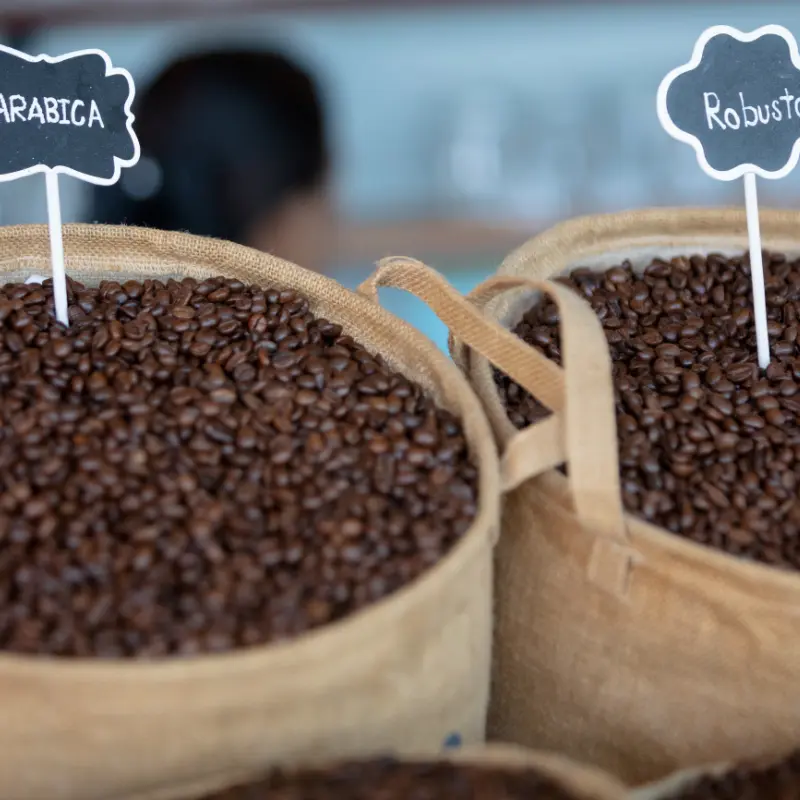
Arabica vs Robusta Varieties
You will notice that not all coffee tastes the same, whether arabica or robusta varieties. This is because the region, altitude, and other growing and processing features determine the overall flavor of the coffee. So, arabica coffee from Brazil will not taste the same as arabica coffee from Kenya.
The same can be said about robusta; robusta beans from Brazil will be completely different from those in Vietnam. In addition to these geographical differences, bean types will also impact flavor and other characteristic differences.
A good example is varieties such as Hawaiian Kona or Tanzanian Peaberry. Hawaiian Kona beans are exclusively grown in Hawaii, although they are a type of arabica beans. Nonetheless, they exhibit distinctive characteristics and qualities that cannot be found elsewhere outside Hawaii.
The same can be said about Tanzania peaberry coffee beans. While they are a type of arabica beans, you cannot find the Tanzanian peaberry bean characteristics and qualities elsewhere.
